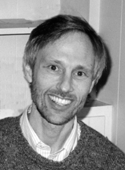- About MAA
- Membership
- MAA Publications
- Periodicals
- Blogs
- MAA Book Series
- MAA Press (an imprint of the AMS)
- MAA Notes
- MAA Reviews
- Mathematical Communication
- Information for Libraries
- Author Resources
- Advertise with MAA
- Meetings
- Competitions
- Programs
- Communities
- MAA Sections
- SIGMAA
- MAA Connect
- Students
- MAA Awards
- Awards Booklets
- Writing Awards
- Teaching Awards
- Service Awards
- Research Awards
- Lecture Awards
- Putnam Competition Individual and Team Winners
- D. E. Shaw Group AMC 8 Awards & Certificates
- Maryam Mirzakhani AMC 10 A Awards & Certificates
- Two Sigma AMC 10 B Awards & Certificates
- Jane Street AMC 12 A Awards & Certificates
- Akamai AMC 12 B Awards & Certificates
- High School Teachers
- News
You are here
Frank Morgan's Math Chat - One Trip to the Attic
 |
November 5, 1998
OLD CHALLENGE (Steve Jabloner). In the lobby of a hotel there are three on/off switches. One is attached to a light bulb on the third floor; the other two are attached to nothing at all. You may work the three switches as often as you please. How many times do you need to visit the third floor to determine which switch is attached to the light bulb?
ANSWER. Neil Bitzenhofer, Jean-Pierre Carmichael, Joe Conrad, Joel Foisy, G. A. Michael, Jon Slutzman, and Walter Wright find a way to do it in one trip. Turn on the first switch, wait ten minutes, and then turn off the first switch and turn on the second switch. Run upstairs. If the light is off but hot, it's the first switch. If the light is on, it's the second switch. If the light is off and cool, it's the third switch.
Dean Thomas rightly advises waiting to make sure that all the switches have been off for a while before you start.
Erik Randolph creatively argues that, "There is no need to run upstairs at all: [just] watch for the blue spark, or even the buzzing sound [from] very, very slowly turning it on and off." His other methods involve a probe or compass. Eric Zeitler would "unscrew the cover plate and check the wiring to see which swich is connected."
"THE PENGUIN DICTIONARY OF CURIOUS AND INTERESTING NUMBERS" by David Wells includes lots of fascinating PRIME numbers (not divisible by any smaller number except 1). One example is 82 81 80 79 78 . . . 1 (with all the numbers from 82 down to 1 in descending sequence). A second, 111. . .1 consists of 1031 repeating units 1; discovered by Williams and Dubner in 1986, it is the largest known repunit (repeating-unit) prime. A third prime has 1104 digits and all of them are prime. A fourth, 1999. . .9 consists of a one followed by 3020 nines. The largest prime listed has already been surpassed by 2^3021377 - 1, discovered on January 27, 1998, by Roland Clarkson, a student at California State University Dominguez Hills, from Norwalk, California. It has almost a million digits.
NEW CHALLENGE. Walter Wright's neighbor Joan was entered to run a special 26.5-mile marathon, and she hoped to average under nine minutes per mile over the total distance. She had a number of friends measure her time over various mile segments of the course, and for each mile that was measured, IN FACT FOR EACH POSSIBLE MILE THAT COULD HAVE BEEN MEASURED (starting anywhere), her time was exactly nine minutes. Was she disappointed? NO--because she claims she met her goal of averaging UNDER nine minutes per mile! Is this possible?
Copyright 1998 Frank Morgan
Send answers, comments, and new questions by email to Frank.Morgan@williams.edu, to be eligible for Flatland and other book awards. Winning answers will appear in the next Math Chat, which appears on the first and third Thursday of each month. Prof. Morgan's homepage is at www.williams.edu/Mathematics/fmorgan.
Note to Readers: This column now appears only on the web. Its continuation in this form will depend on reader response. Questions,answers, and comments are all most welcome.




